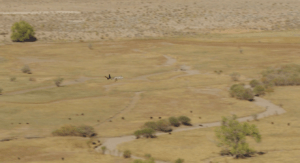DRONELIFE talks to Jon Damush about the place of onboard detect-and-avoid in the complex system of drone safety.
Drone startup Iris Automation offers a cutting edge solution for a foundational problem: how to prevent drones from running into anything. Iris’ onboard detect-and-avoid system, Casia, offers a new layer of safety to automated drone flights. DRONELIFE spoke with drone industry veteran and newly appointed CEO of Iris Automation Jon Damush on what onboard detect-and-avoid systems can – and can’t – do to push the drone industry forward.

Damush came from the Boeing family, where he served as Chief Growth Officer at Boeing subsidiary Insitu, and then the leader of new business ventures at Boeing NeXT. His deep experience in aviation – both manned and unmanned – gives him a unique perspective on how aviation is changing with the growth of the unmanned sector.
When Damush looks at the aviation market, he tries to answer one critical question: Why fly? “Flying is rarely the cheapest or most reliable method,” says Damush.
“Flying is still comparatively hard. Think about the manned aviation industry that we know today: when you look into everything that makes that work, it’s the result of 100 years of constant improvement and innovation.”
“There are some very specific use cases for flying,” Damush explains. “An aerial perspective is a different perspective, and that can be really valuable. You can move people or goods. There are military uses. But none of these are new – people have been spraying crops or taking pictures from the air for a long time.”
The unmanned industry didn’t invent aerial applications: but unmanned systems make those applications more cost effective. “The economic prospect for robotic aircraft is really, really, good,” says Damush. “Ultimately, you want to get to the point that you have one pilot operating many aircraft – then you realize the economies of scale.”
The current aviation framework of safety regulations isn’t designed to accommodate fleets of unmanned aircraft yet, however. “When a Cessna 172 gets certified for flight, it doesn’t have detect and avoid onboard. That’s the pilot’s job,” says Damush. If all of the regulations and air traffic controls in place don’t prevent another aircraft from getting too close, the pilot sees it coming and changes course. On unmanned aircraft, onboard detect and avoid systems like Casia are designed to work like the human eye: to see what’s coming, and tell the autopilot to avoid it.
“Safety in this environment is never the result of one approach – it takes a layered approach,” Damush says. Conflict avoidance is managed by a combination of “strategic flight planning, airspace regulations, certifications, and what’s codified in the rules in terms of right of way. You have tactical tools like ADS-B, transponders, radar, and air traffic controllers. ”
“Then you have the last line of defense – your in aircraft capabilities. On a Cessna that’s the lights, and a pilot. It’s all of these things stacked together that lead to a safe flight, but the pilot is the last line of defense. That’s where Casia is focused – we’re building a system that is comparable to the human eyeball, to provide the last line of defense when there is no human operator.”
Casia, with a 360 degree vision, already has better eyesight than the average human pilot; without some of the human frailties. “The point of a vision system is that it doesn’t have to do anything else – it doesn’t get tired, it doesn’t get distracted,” says Damush. “It offloads a lot of the pain from the existing system.”
Iris Automation is also working to integrate that vision tool with the other tools that go into a robust conflict avoidance system, communicating with UTM systems and other safety technologies seamlessly, all without the active intervention of human operators. “We need to make systems easier to use – and by doing that we make them safer. Increased use of automation makes things safer,” Damush says.
In the context of this week’s National Drone Safety Awareness week, Damush’s message about onboard detect-and-avoid is clear. Vision technology is one tool that will help with the problem of collision avoidance: but it doesn’t claim to do it all. Integrating drones safely into the NAS requires multiple systems and technologies to work together.
“People have to understand that aviation safety is a set of interacting elements – it’s never about one single technology,” Damush says.

Miriam McNabb is the Editor-in-Chief of DRONELIFE and CEO of JobForDrones, a professional drone services marketplace, and a fascinated observer of the emerging drone industry and the regulatory environment for drones. Miriam has penned over 3,000 articles focused on the commercial drone space and is an international speaker and recognized figure in the industry. Miriam has a degree from the University of Chicago and over 20 years of experience in high tech sales and marketing for new technologies.
For drone industry consulting or writing, Email Miriam.
TWITTER:@spaldingbarker
Subscribe to DroneLife here.








[…] réellement, Iris Automation a expliqué comment la technologie de détection et d’évitement peut être utilisé pour atténuer le risque de collisions en vol. Cela a permis à l’entreprise de décrire un large éventail […]